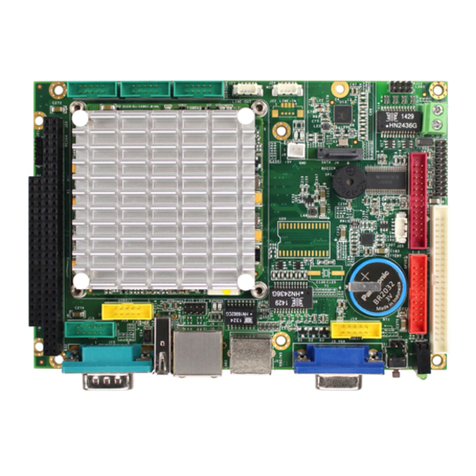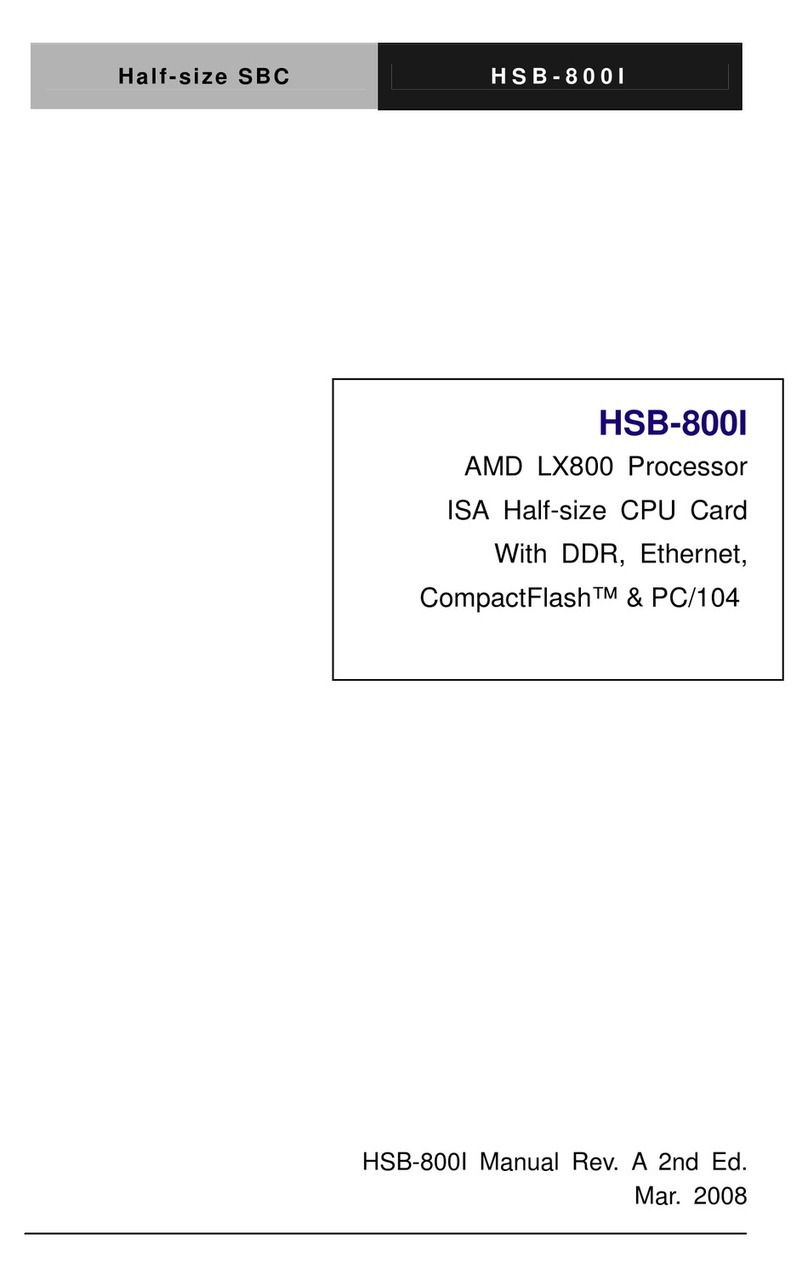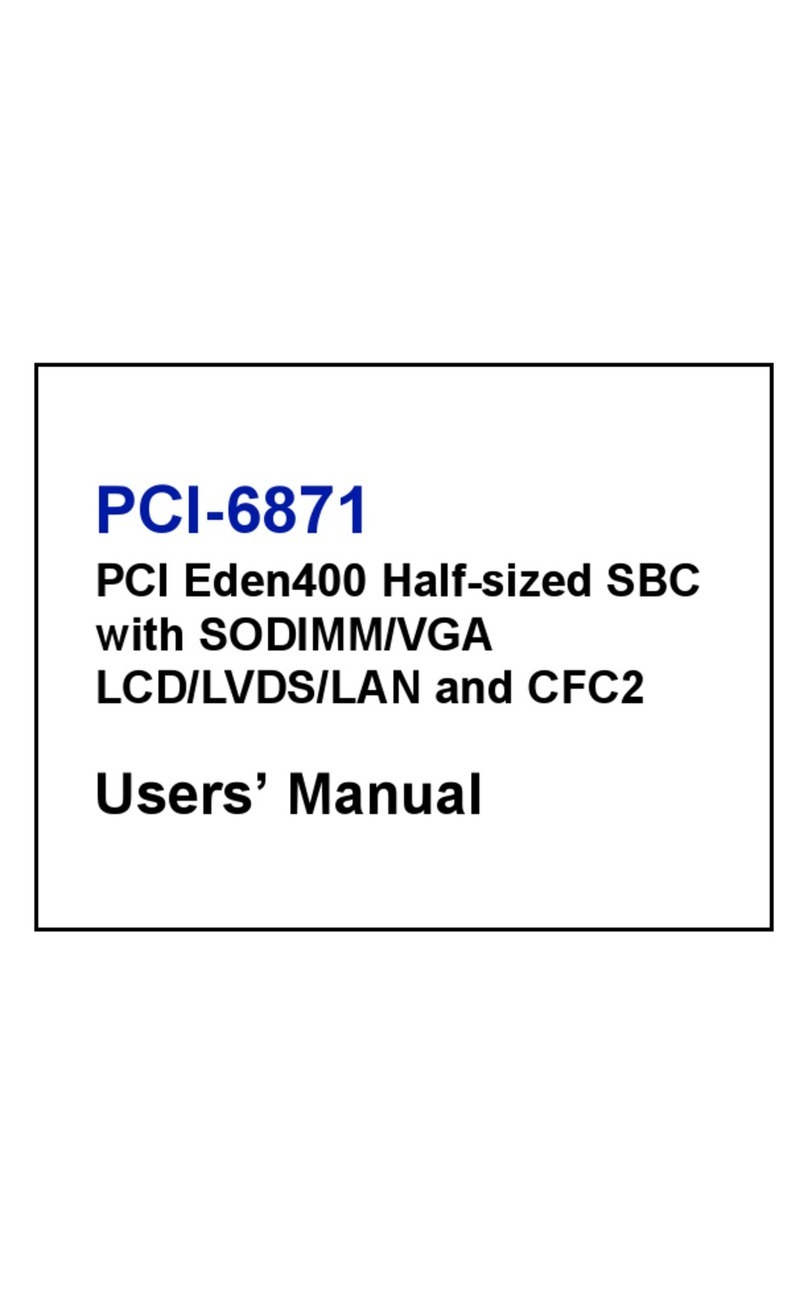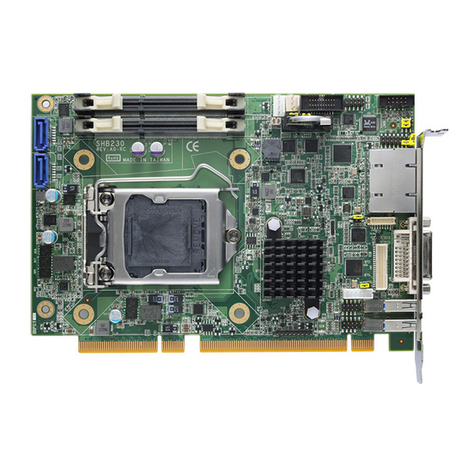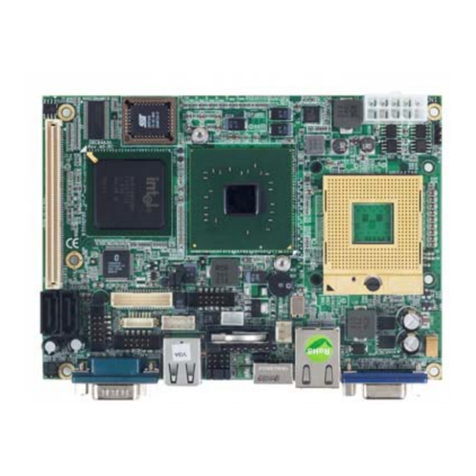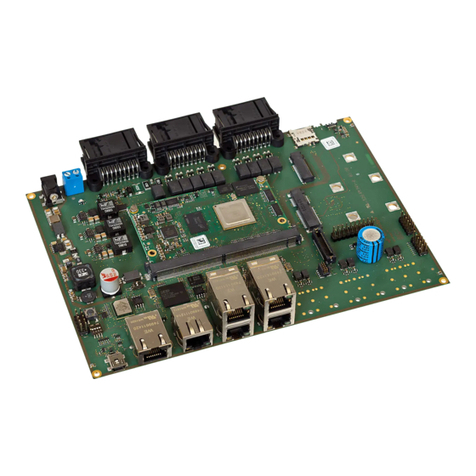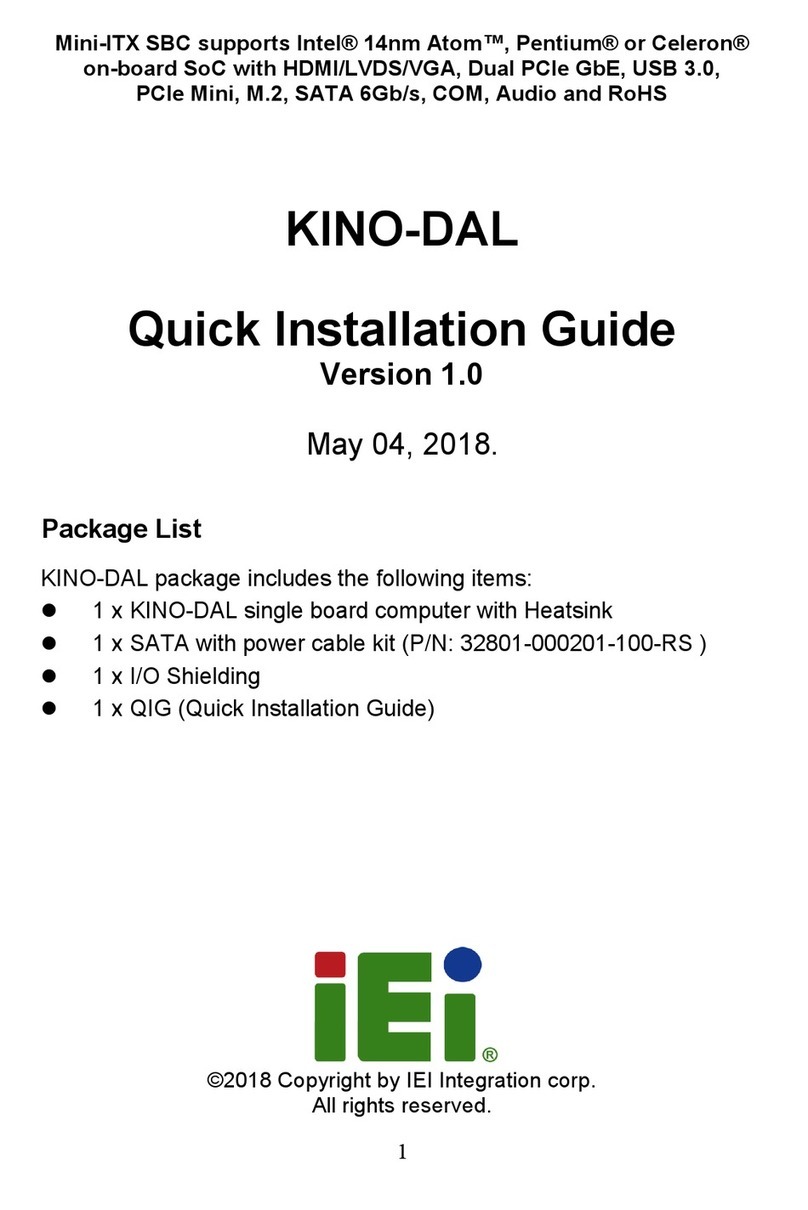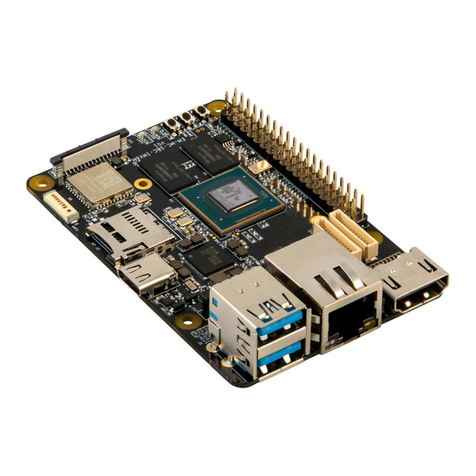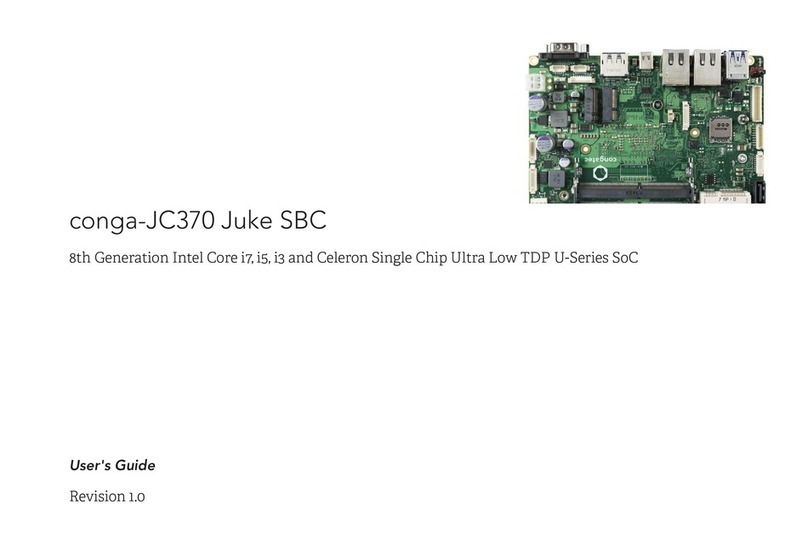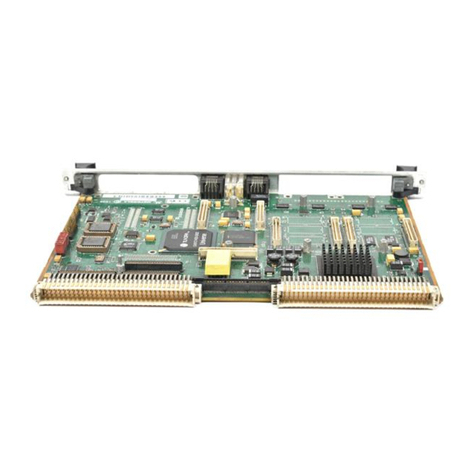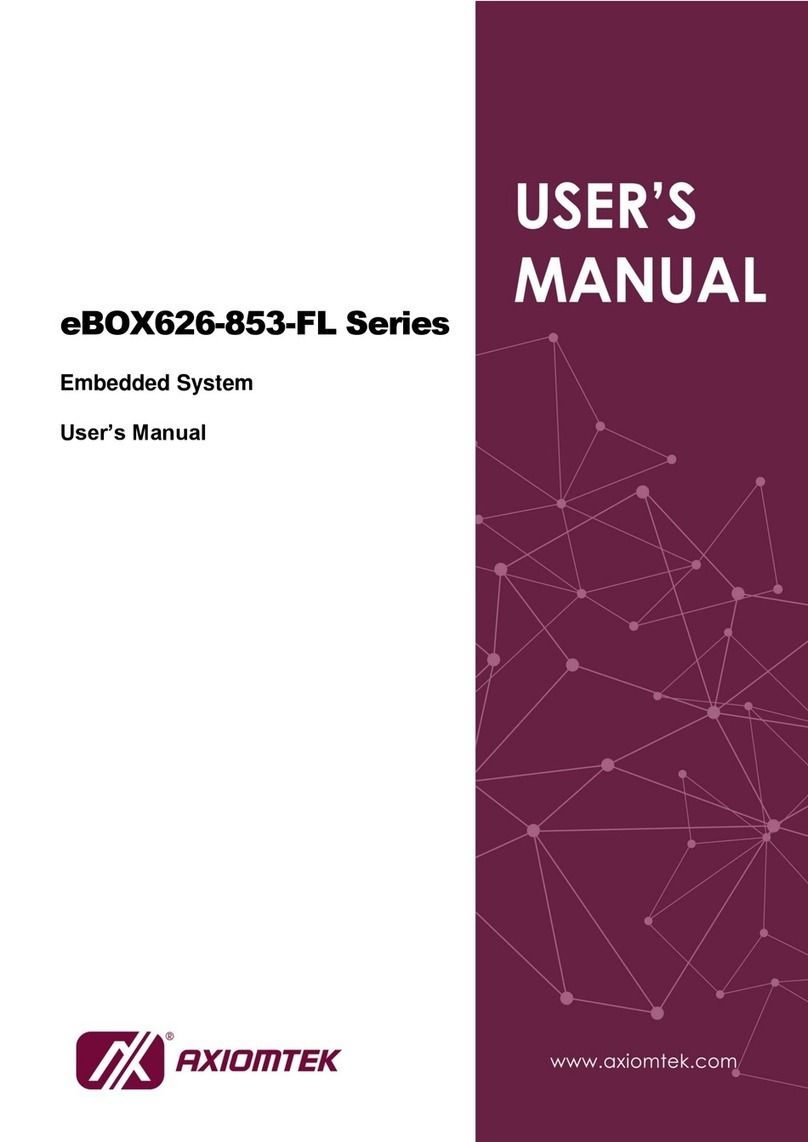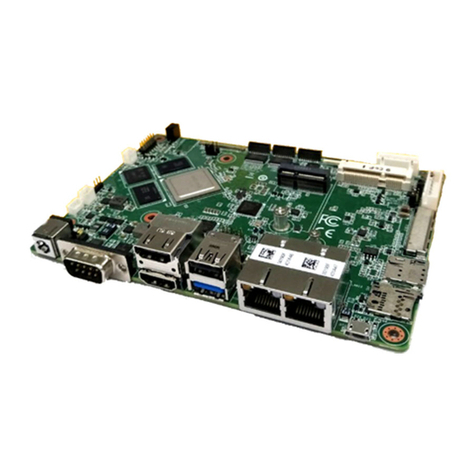EMAC SoM-3354M User manual

SoM-3354M
User Manual
REV. 1.4
Copyright 2021
EMAC, Inc.
2390 EMAC Way, Carbondale, Illinois 62902
Phone: (618) 529-4525 Fax: (618) 457-0110
http://www.emacinc.com

Table of Contents
1. Introduction..................................................................................................................................... 2
1.1. Features........................................................................................................................................................................2
2. Hardware......................................................................................................................................... 3
2.1. Specifications...............................................................................................................................................................3
2.2. External Connections...................................................................................................................................................4
2.2.1. System Control & External Bus.......................................................................................................................4
2.2.2. USB.....................................................................................................................................................................5
2.2.3. JTAG...................................................................................................................................................................5
2.2.4. Ethernet ..............................................................................................................................................................5
2.2.5. I2C........................................................................................................................................................................6
2.2.6. SPI.......................................................................................................................................................................6
2.2.7. CAN.....................................................................................................................................................................7
2.2.8. IRQs....................................................................................................................................................................7
2.2.9. Oscillators...........................................................................................................................................................7
2.2.10. SD/Multimedia Card......................................................................................................................................7
2.2.11. I2S Audio........................................................................................................................................................8
2.2.12. Serial Ports.....................................................................................................................................................8
2.2.13. GPIO ...............................................................................................................................................................9
2.2.14. Touchscreen / Analog-to-Digital Convertor (ADC).................................................................................10
2.2.15. LCD ...............................................................................................................................................................10
2.2.16. Boot Options ................................................................................................................................................11
2.2.17. Power Connections.....................................................................................................................................11
2.3. Real-Time Clock........................................................................................................................................................11
2.4. Watchdog Timer ........................................................................................................................................................11
2.5. Status LED.................................................................................................................................................................11
3. Design Considerations.................................................................................................................. 12
3.1. The EMAC SoM Carrier-SoM-200ES.......................................................................................................................12
3.2. Power.........................................................................................................................................................................12
3.2.1. Battery Backup ................................................................................................................................................12
3.2.2. Shutdown Logic Pins......................................................................................................................................12
4. Software......................................................................................................................................... 13

SoM-3354M User Manual.docx -1- Rev 1.4 © 2021 EMAC, Inc.
Disclaimer
EMAC Inc. does not assume any liability arising out of the application or use of any of its products or designs.
Products designed or distributed by EMAC Inc. are not intended for, or authorized to be used in, applications such
as life support systems or for any other use in which the failure of the product could potentially result in personal
injury, death or property damage.
If EMAC Inc. products are used in any of the aforementioned unintended or unauthorized applications, Purchaser
shall indemnify and hold EMAC Inc. and its employees and officers harmless against all claims, costs, damages,
expenses, and attorney fees that may directly or indirectly arise out of any claim of personal injury, death or property
damage associated with such unintended or unauthorized use, even if it is alleged that EMAC Inc. was negligent in
the design or manufacture of the product.
EMAC Inc. reserves the right to make changes to any products with the intent to improve overall quality, without
further notification.

SoM-3354M User Manual.docx -2- Rev 1.4 © 2021 EMAC, Inc.
1. Introduction
This document describes the EMAC SoM-3354M System on Module. The SoM-3354M is designed to be compatible
with EMAC's 200-pin SODIMM form factor. This module is built around the Texas Instruments AM3354 ARM Cortex-
A8 based microprocessor, which provides several of its key features.
The SoM-3354M has an on-board Ethernet PHY, 4 serial ports, eMMC, USB Switch, SPI flash, and DDR3 SDRAM.
In addition to these standard SoM features, the SoM-3354M also features a fast 32-bit core, hardware graphics
accelerators, open source software support, and a wide range of controller IO pins.
1.1. Features
Small, 200 pin SODIMM form factor (2.66" x 2.375")
Texas Instruments AM3354 ARM Cortex-A8 1Ghz processor (s-PBGA 324)
10/100BaseT Ethernet with on-board PHY
3 Serial ports with RTS/CTS handshake (transceiver on carrier)
1 Serial port with full handshake (transceiver on carrier)
2 USB 2.0 (High Speed) Host ports (uses a USB Hub chip)
1 USB 2.0 (High Speed) OTG Host/Device port
512 MB of DDR3L SDRAM
16 MB of SPI Flash
4GB eMMC Flash
External MMC/SD card interface with card detect
Real-Time Clock Internal with battery backed provision
2 SPI port
I2C hardware port
Synchronous I2C analog audio interface port
1 CAN port (transceiver on carrier)
2 Timer/Counter/PWM
Internal Resistive Touchscreen Controller with 4-Channel 12-bit Analog-to-Digital converter
16-bit TFT LCD interface
True Random Number Generator
JTAG for debug, including real-time trace
FREE Qt Creator based IDE
There are certain product variations that can be ordered without some of these features for cost-sensitive
applications. Contact sales for more details.

SoM-3354M User Manual.docx -3- Rev 1.4 © 2021 EMAC, Inc.
2. Hardware
2.1. Specifications
CPU: Texas Instruments AM3354 processor running at 1 GHz.
Flash: 4GB of eMMC and 16 MB SPI Flash.
RAM: 512MB of DDR3L SDRAM
Video: 2D/3D Accelerated 16 Bit LCD Video Interface with up to 2048 x 2048 resolution.
Touchscreen: 12-Bit, up to 4-wire, 5-wire, 8-wire analog resistive touchscreen interface.
Flash Disk: Up to 16 GB eMMC Flash upgrade.
System Reset: Processor Internal Reset Management with External Reset Button provision.
RTC: Real-Time Clock Internal with battery-backed provision.
Timers/Counters: 2 Timer/Counter/PWM
Digital I/O: Many general purpose I/Os multiplexed with peripheral interfaces.
Analog I/O: 8 channels total, 4 of which is shared by the resistive touchscreen.
Power: Power Management Controller allows selective shutdown capability on processor I/O functionality
and running from a slow clock.
JTAG: JTAG for debug, including real-time trace.
Serial Interfaces
USB:
2 USB 2.0 High Speed Host ports.
1 USB 2.0 High Speed Host or Device (USB OTG) software configurable.
UARTS: 3 with RTS/CTS handshaking, 1 with full handshaking.
SPI: 2 High-Speed SPI ports with 4 Chip Slave Selects.
I2C: I2C hardware port
Audio: 2 I2S Synchronous Serial Controller with analog interface support.
CAN: Processor Internal, High End CAN Controller (HECC).
Ethernet Interface
MAC: Ethernet on chip MAC
PHY: Micrel KSZ8041NL with software PHY shutdown control
Interface: IEEE 802.3u 10/100 BaseT Fast Ethernet (requires external magnetics and jack)
Bus Interface
ARM EBI accessible through SODIMM provides 11 address lines, 8 data bus lines, and control lines.
Mechanical and Environmental
Dimensions: SODIMM form factor with the length dimension extended (2.66" x 2.375")
SODIMM TYPE: 200 Pin DDR1 (not compatible with DDR2 sockets)
Power Supply Voltage: +3.3 Volts DC +/- 5%
Typical Power Requirements:
3.3 Volts @ TBD.
Current draw during boot process: TBD.
Constant busy loop: TBD.
Constant busy loop with Ethernet PHY disabled: TBD
Idle system: TBD.
Idle system with Ethernet PHY disabled: TBD
APM sleep mode using slow clock with Ethernet PHY disabled: TBD
APM sleep mode using slow clock with Ethernet PHY enabled: TBD
Operating Temperature: -40 ~ 85° C (-40 ~ 185 ° F), fanless operation.
Operating Humidity: 0% ~ 90% relative humidity, non-condensing

SoM-3354M User Manual.docx -4- Rev 1.4 © 2021 EMAC, Inc.
2.2. External Connections
The SoM-3354M connects to a carrier board containing its connectors, power supply and any
expansion IO, through a standard gold-plated SODIMM 200-pin connection shown below.
The use of the DDR SODIMM form-factor for EMAC’s SoMs is a sound choice that has been proven
rugged and reliable in the laptop and embedded SBC markets.
The SoM model will fit in any standard 200-pin DDR1 SODIMM socket (but not DDR2 sockets). These
connections are designed according to the 200-pin SoM specification “SOM200_specpublic_xxxxx.pdf”
in order to be compatible with all EMAC 200-pin SoMs. See “SOM200_specpublic_xxxxx.pdf” to
compare other 200-pin SoM pinouts to the SoM-3354M’s pinout.
The remainder of this section describes the pinout as it applies specifically to the SoM-3354M.
2.2.1. System Control & External Bus
The SoM-3354M provides a flexible external bus for connecting peripherals. The CPLD of the SoM-200ES
Carrier board connects through a subset of these connections.
SODIMM
Pin#
SoM
Pin Name
Processor
Pin Name(s)
Port Line
Description
145
GP_CSA
GPMC_CSN1
GPIO 1_30
General Purpose Chip Select CS1
146
GP_CSB
GPMC_CSN2
GPIO 1_31
General Purpose Chip Select CS2
147
GP_CSC
GPMC_CSN3
GPIO 2_0
General Purpose Chip Select CS3
148
GP_CSD/Shutdown
GPMC_CSN6
GPIO 1_28
General Purpose Chip Select CS4
149
~WR
GPMC_WE
GPIO 2_4
Write Signal
150
~RD/TIP
GPMC_OE
GPIO 2_3
Read Signal
151
~RST_IN
SYS_RESETN
Processor Reset
152
~RST_OUT
SYS_RESETN
Processor Reset
153
~WAIT
GPMC_WAIT1
GPIO 2_1
Shutdown Control
154
~FLASH WP
NC
Flash Write Protect
54
WAKEUP
NC
Processor Wakeup Input
157
BOOT_OPTION0
SYS_BOOT[4:0]
Boot0 Option Select
158
BOOT_OPTION1
SYS_BOOT[4:0]
Boot1 Option Select
175-186
A0 –A11
GPMC_A0 –
GPMC_A10
GPIO
1_16-1_27
Address Bus
159 –166
D0 –D7
GPMC_AD0 –
GPMC_AD7
GPIO 1_0-
1_7
Data Bus
167 –174
D8 –D15
NC
Data Bus
187-196
A12- A21
NC
Address Bus

SoM-3354M User Manual.docx -5- Rev 1.4 © 2021 EMAC, Inc.
2.2.2. USB
The 200-pin SoM specification provides for 2 USB hosts and 1 USB device or OTG port. The AM3354
provides a USB 2.0 OTG port and a USB 2.0 host port interface.
SODIMM
Pin#
SoM
Pin Name
Processor
Pin Name(s)
Port Line
Description
5
Host_A+
HDPA1
Host USB Switch Port0 + pin
7
Host_A-
HDMA1
Host USB Switch Port0 –pin
6
Host_B+
HDPA2
Host USB Switch Port1 + pin
8
Host_B-
HDMA2
Host USB Switch Port1 –pin
9
Host/Device/OTG_C-
USB0_DM
OTG USB 2.0 Port0 –pin
11
Host/Device/OTG_C+
USB0_DP
OTG USB 2.0 Port0 + pin
10
USB_OTG_VBUS
USB0_VBUS
OTG VBUS
40
USB_OTG_ID
USB0_ID
OTG ID
2.2.3. JTAG
The SoM specification allows for access to the JTAG lines for the AM3354 processor. These connections
will allow the Flash to be programmed in circuit via a program running from the processor and also the
capability to debug software.
SODIMM
Pin#
SoM
Pin Name
Processor
Pin Name(s)
Description
139
JTAG_TCK
JTAG_TCK
JTAG clock
140
JTAG_TDI
JTAG_TDI
JTAG serial in
141
JTAG_TDO
JTAG_TDO
JTAG serial out
142
JTAG_TMS
JTAG_TMS
JTAG operation mode
143
JTAG_TRST
JTAG_TRST
Test Reset Signal
144
JTAG_RTCK
NC
Dynamic clock sync
2.2.4. Ethernet
The SoM-3354M provides a Micrel KSZ8041 Ethernet 10/100 PHY IC on board. Carrier designers need
only to run these lines through the appropriate magnetics layer to have a functional Ethernet connection.
Remember, the RX and TX lines are differential pairs and need to be routed as such.
The state of the LED/configuration pins at reset determines the Ethernet’s configuration (10-baseT, 100-
baseT, autoconfig) and the function of the LED’s. The SoM-200ES pulls them all high, which configures the
chip for network autoconfig, with ETH_LED1 functioning as an active low link and ETH_LED2 functioning
as active low Activity status (Refer to Carrier schematics).

SoM-3354M User Manual.docx -6- Rev 1.4 © 2021 EMAC, Inc.
SODIMM
Pin#
SoM
Pin Name
PHY
Pin Name
Description
12
GIG D-
NC
GIG Ethernet D- pin
14
GIG D+
NC
GIG Ethernet D+ pin
13
GIG C-
/Host/Device/OTG_C-
NC
GIG Ethernet C- pin
15
GIG C+
NC
GIG Ethernet C+ pin
16
Ethernet_Rx-/GIG B-
Etherent_Rx-
Low differential Ethernet receive line
18
Ethernet_Rx+/GIG B+
Ethernet_Rx+
High differential Ethernet receive line
17
Etherent_Tx-/GIG A-
Etherent_Tx-
Low differential Ethernet transmit line
19
Ethernet_Tx+/GIG A+
Ethernet_Tx+
High differential Ethernet transmit line
38
LED_LINK/CFG_2
ETH_LED1
Ethernet Link LED/Configuration pin
39
LED_ACT/CFG_3
ETH_LED2
Ethernet Activity LED/Configuration pin
2.2.5. I2C
The 200-pin SoM specification calls for a two-wire I2C port. The SoM-3354M has a native hardware I2C
port.
SODIMM
Pin#
SoM
Pin Name
Processor
Pin Name(s)
Port
Line
Description
29
I2CCLK
I2C2_SCL
GPIO
3_6
Clock pin
30
I2CDATA
I2C2_SDA
GPIO
3_5
Data pin
2.2.6. SPI
The AM3354 processor provides 4 SPI channels for communicating with peripheral devices. Two of the
SPI channels have been provided via the SoM edge connector. The first table below lists the lines for the
dedicated SPI channel.
SODIMM
Pin#
SoM
Pin Name
Processor
Pin Name(s)
Port Line
Description
22
SPI_MI
SPI0_D0
GPIO 0_3
SPI1 serial data in
23
SPI_MO
SPI0_D1
GPIO 0_4
SPI1 serial data out
24
SPI_SCK
SPI0_SCLK
GPIO 0_2
SPI1 serial clock out
25
SPI_CS0
GPMC_AD15
GPIO 1_15
SPI1 slave select line 0
26
SPI_CS1
EMU1
GPIO 3_8
SPI1 slave select line 1
27
SPI_CS2
GPMC_AD14
GPIO 1_14
SPI1 slave select line 2
28
SPI_CS3/SPI
_Frame
MCASP0_ACLKR
GPIO 3_18
SPI1 slave select line 3

SoM-3354M User Manual.docx -7- Rev 1.4 © 2021 EMAC, Inc.
The table below documents the SPI channel 2, which shares pins in the GPIO pin section.
SODIMM
Pin#
SoM
Pin Name
Processor
Pin Name(s)
Port Line
Description
125
GPIO11
UART0_CTSn
GPIO 1_8
SPI2 serial data in
126
GPIO12
UART0_RTSn
GPIO 1_9
SPI2 serial data out
127
GPIO13
ECAP0_IN_PWM0_OUT
GPIO 0_7
SPI2 serial clock out
2.2.7. CAN
The AM3354 provides a High-End CAN Controller (HECC) internally. The CAN interface lines are directed
to the dedicated CAN pads on the SoM connector as shown in the table below.
SODIMM
Pin#
SoM
Pin Name
Processor
Pin Name(s)
Port Line
Pin Description
93
CANTX
MII1_TXD3
GPIO 0_16
CAN Transmit
94
CANRX
MII1_TXD2
GPIO 0_17
CAN Receive
2.2.8. IRQs
The 200-pin SoM specification allocates three pins as IRQs. The AM3354 processor can use virtually any
GPIO pin to trigger an interrupt. EMAC used the following GPIO lines for general purpose IRQs:
SODIMM
Pin#
SoM
Pin Name
Processor
Pin Name(s)
Port Line
SoM Description
129
IRQA
XDMA_EVENT_INTR0
GPIO 0_19
Interrupt A
130
IRQB
MCASP0_FSR
GPIO 3_19
Interrupt B
131
IRQC
MCASP0_AHCLKX
GPIO 3_21
Interrupt C
2.2.9. Oscillators
The 200-pin SoM specification provides for two general-purpose oscillators. These frequencies can vary
slightly between modules depending on how they are generated and some modules may not provide 50%
duty cycles. The AM3354 uses a clock generator chip (Si5351A) to generate these frequencies. The
frequencies are programmable via software. The Si5351A also provides the clock source for the on-board
Dual UART (TL16C2550IPFB) chip.
SODIMM
Pin#
SoM
Pin Name
Processor
Pin Name(s)
Port Line
SoM Description
132
OSC0 (high)
N/A
Si5351A (CLK_1)
~ 8 MHz
133
OSC1 (low)
GPMC_BEn0_CLE
GPIO 1_15
~ 200 KHz
2.2.10. SD/Multimedia Card
The AM3354 processor provides multiple 4-bit MMC/SD card interface using the MCI lines. The SoM-
200ES & 210ES Carrier boards can use a parallel MMC/SD interface if available.
The 200-pin SoM specification provides for three optional SD/MMC control lines. Since these lines are
optional and will not always be used they are not part of the SD/MMC group, but, instead, are part of the

SoM-3354M User Manual.docx -8- Rev 1.4 © 2021 EMAC, Inc.
GPIO group. SoM pin#s 122, 123, and 124 can be used as SD_LED, SD_Power, and SD_protect,
respectively.
MMC2 is allocated to the SoM Pin Specification in the SD/MMC section as the default SD port. This port
should be used to maintain compatibility with past and future modules. As mentioned about the AM3354
processor provides multiple SD ports. The MMC1 port is allocated to the on-module eMMC chip.
SODIMM
Pin#
SoM
Pin Name
Processor
Pin Name(s)
Port Line
Description
31
SDCLK
GPMC_CSn1
GPIO 1_30
MCI Clock
32
CMD
GPMC_CSn2
GPIO 1_31
MCIA Command
33
DAT0
GPMC_AD8
GPIO 0_22
MCIA D0
34
DAT1
GPMC_AD9
GPIO 0_23
MCIA D1
35
DAT2
GPMC_AD10
GPIO 0_26
MCIA D2
36
DAT3
GPMC_AD11
GPIO 0_27
MCIA D3
37
Card_Detect
GPMC_AD12
GPIO 1_12
Card Detect
2.2.11. I2S Audio
The AM3354 provides multiple I2S audio ports that are accommodated within the SoM specification. Note
that there is no CODEC on the SoM and therefore must be provided on the Carrier. In addition the CODEC
will require either SPI or I2C for control.
The Master clock is derived by a clock generator chip to drive the Si5351A (CLK_2) 12.288MHZ oscillator.
The Si5351A provides the clock source for on board Dual UART (TL16C2550IPFB) chip.
SODIMM
Pin#
SoM
Pin Name
Processor
Pin Name(s)
Port Line
Description
86
AudioA_SCLK
MCASP0_ACLKX
GPIO 3_14
I2S Serial Clock
87
AudioA_LRCLK/Frame
MCASP0_FSX
GPIO 3_15
I2S Left / Right Clock
88
AudioA_MCLK
N/A
Si5351A
(CLK_2)
I2S Master Clock
89
AudioA_DIN
MCASP0_AXR0
GPIO 3_16
I2S Data Input
90
AudioA_DOUT
MCASP0_AXR1
GPIO 3_20
I2S Data Output
2.2.12. Serial Ports
The 200-pin SoM specification has the provision for 4 serial ports. The AM3354 processor provides full
modem handshaking for COMA. The SoM-3354M uses a Dual UART (TL16C2550IPFB) chip to provide
additional serial ports.
SODIMM
Pin#
SoM
Pin Name
Processor
Pin Name(s)
Port Line
SoM Description
95
COMA_TXD
EUART0_TX
COMA transmit/GPIO
96
COMA_RXD
EUART0_RX
COMA receive/GPIO
97
COMA_CTS
EUART0_CTS
COMA CTS/GPIO
98
COMA_RTS
EUART0_RTS
COMA RTS/GPIO
99
COMA_DTR
EUART0_DTR
COMA DTR/GPIO
100
COMA_DSR
EUART0_DSR
COMA DSR /GPIO
101
COMA_RI
EUART0_RI
COMA RING/GPIO

SoM-3354M User Manual.docx -9- Rev 1.4 © 2021 EMAC, Inc.
SODIMM
Pin#
SoM
Pin Name
Processor
Pin Name(s)
Port Line
SoM Description
102
COMB_TXD
UART0_TXD
GPIO 1_11
COMB transmit/GPIO
103
COMB_RXD
UART0_RXD
GPIO 1_10
COMB receive/GPIO
104
COMB_CTS
NC
COMB CTS/GPIO
105
COMB_RTS
NC
COMB RTS/GPIO
106
COMC_TXD
UART1_TXD
GPIO 0_15
COMC transmit/GPIO
107
COMC_RXD
UART1_RXD
GPIO 0_14
COMC receive/GPIO
108
COMC_CTS
UART1_CTSn
GPIO 0_12
COMC CTS/GPIO
109
COMC_RTS
UART1_RTSn
GPIO 0_13
COMC RTS/GPIO
110
COMD_TXD
EUART1_TX
COMD transmit/GPIO
111
COMD_RXD
EUART1_RX
COMD receive/GPIO
112
COMD_CTS
EUART1_CTS
COMD CTS/GPIO
113
COMD_RTS
EUART1_RTS
COMD RTS/GPIO
2.2.13. GPIO
This section provides for the SoM general purpose IO section. All of these pins can be configured to be
general-purpose digital ports. They can also be configured to take advantage of several alternate functions
of the AM3354 processor.
The SoM-3354M uses a GPIO Expander chip (MCP23S08-E/ML) to provide additional GPIO.
SODIMM
Pin#
SoM
Pin Name
Processor
Pin Name(s)
Port Line
Description
114
GPIO0
GPMC_AD13
GPIO 1_13
GPIO/LCD Backlight On/Off
115
GPIO1
EGPIO0
GPIO EXPANDER
GPIO
116
GPIO2
EGPIO1
GPIO EXPANDER
GPIO
117
GPIO3
EGPIO2
GPIO EXPANDER
GPIO
118
GPIO4
EGPIO3
GPIO EXPANDER
GPIO
119
GPIO5
EGPIO4
GPIO EXPANDER
GPIO
120
GPIO6
EGPIO5
GPIO EXPANDER
GPIO
121
GPIO7
EGPIO6
GPIO EXPANDER
GPIO
122
GPIO8
EGPIO7
GPIO EXPANDER
GPIO
123
GPIO9
EMU0
GPIO 3_7
GPIO/SD_Power
124
GPIO10
USB0_DRVVBUS
GPIO 0_18
GPIO/SD_Protect
125
GPIO11
UART0_CTSn
GPIO 1_8
GPIO
126
GPIO12
UART0_RTSn
GPIO 1_9
GPIO
127
GPIO13
ECAP0_IN_PWM0_OUT
GPIO 0_7
GPIO
128
GPIO14
GPMC_ADVn_ALE
GPIO 2_2
GPIO
134
GPIO15
XDMA_EVENT_INTR1
GPIO 0_20
GPIO

SoM-3354M User Manual.docx -10- Rev 1.4 © 2021 EMAC, Inc.
2.2.14. Touchscreen / Analog-to-Digital Convertor (ADC)
The 200-pin SoM specification allocates SoM pins that can be utilized as Touchscreen or ADC inputs. The
AM3354 has a resistive touchscreen controller that can be configured to operate as a 4, 5 or 8-wire
interface.
SODIMM
Pin#
SoM
Pin Name
Processor
Pin Name(s)
Description
45
X+/Xr/ADC0
AIN0
X+
46
X-/Xl/ADC1
AIN1
X-
47
Y+/Yu/ADC2
AIN2
Y+
48
Y-/Yd/ADC3
AIN3
Y-
49
SX+/ADC4
AIN4
SX+
50
SX-/ADC5
AIN5
SX-
51
SY+/ADC6
AIN6
SY+
52
SY-/ADC7
AIN7
SY-
2.2.15. LCD
The 200-pin SoM specification has provision for up to 16-bit LCDs (565 RBG mode). These lines can also
be used to provide analog VGA connectivity for use with a conventional monitor by adding a video DAC to
the Carrier. A Brightness PWM is also provided to allow for software control of the LCD’s Brightness. SoM
pin# 114 can be used to turn the LCD backlight On and Off if desired.
SODIMM
Pin#
SoM
Pin Name
Processor
Pin Name(s)
Port Line
SoM Description
57
LCD_BLUE0
LCD_DATA0
GPIO 2_6
LCD BLUE0
58
LCD_BLUE1
LCD_DATA0
GPIO 2_6
LCD BLUE1
59
LCD_BLUE2
LCD_DATA0
GPIO 2_6
LCD BLUE2
60
LCD_BLUE3
LCD_DATA0
GPIO 2_6
LCD BLUE3
61
LCD_BLUE4
LCD_DATA1
GPIO 2_7
LCD BLUE4
62
LCD_BLUE5
LCD_DATA2
GPIO 2_8
LCD BLUE5
63
LCD_BLUE6
LCD_DATA3
GPIO 2_9
LCD BLUE6
64
LCD_BLUE7
LCD_DATA4
GPIO 2_10
LCD BLUE7
65
LCD_GREEN0
LCD_DATA5
GPIO 2_11
LCD GREEN0
66
LCD_GREEN1
LCD_DATA5
GPIO 2_11
LCD GREEN1
67
LCD_GREEN2
LCD_DATA5
GPIO 2_11
LCD GREEN2
68
LCD_GREEN3
LCD_DATA6
GPIO 2_12
LCD GREEN3
69
LCD_GREEN4
LCD_DATA7
GPIO 2_13
LCD GREEN4
70
LCD_GREEN5
LCD_DATA8
GPIO 2_14
LCD GREEN5
71
LCD_GREEN6
LCD_DATA9
GPIO 2_15
LCD GREEN6
72
LCD_GREEN7
LCD_DATA10
GPIO 2_16
LCD GREEN7
73
LCD_RED0
LCD_DATA11
GPIO 2_17
LCD RED0
74
LCD_RED1
LCD_DATA11
GPIO 2_17
LCD RED1
75
LCD_RED2
LCD_DATA11
GPIO 2_17
LCD RED2
76
LCD_RED3
LCD_DATA11
GPIO 2_17
LCD RED3
77
LCD_RED4
LCD_DATA12
GPIO 0_8
LCD RED4
78
LCD_RED5
LCD_DATA13
GPIO 0_9
LCD RED5
79
LCD_RED6
LCD_DATA14
GPIO 0_10
LCD RED6
80
LCD_RED7
LCD_DATA15
GPIO 0_11
LCD RED7
81
LCD_HORZ/LP
LCD_HSYNC
GPIO 2_23
Horizontal Sync
82
LCD_VERT/FP/FLM
LCD_VSYNC
GPIO 2_22
Vertical Sync
83
LCD_ENABLE/DE/M
LCD_AC_BIAS_EN
GPIO 2_25
Enable
84
LCD_CLK/SFK/SHFCLK
LCD_PCLK
GPIO 2_24
LCD Clock
85
BCKLIGHT/PWM
MCASP0_AHCLKR
GPIO 3_17
Backlight Brightness Control

SoM-3354M User Manual.docx -11- Rev 1.4 © 2021 EMAC, Inc.
2.2.16. Boot Options
The 200-pin SoM specification provides two pins for boot-time configuration. On the SoM-3354M they are
used to select between four boot modes.
BOOT1
BOOT0
SYS_BOOT[4:0]
BOOT MODE
Description
0
0
10110
SPI0
Boot from SPI Flash.
0
1
10111
MMC0
Boot from on-board eMMC (see note)
1
0
10110
UART0/EMAC1
Boot from Serial/Ethernet.
1
1
10111
UART0/USB0
Boot from Serial/USB.
The SoM-3354M is capable of booting out of Serial, Ethernet, SPI Flash, or USB. Booting from eMMC is
only possible with a custom populated version. Contact EMAC for more details. Minimum purchase
quantities apply.
2.2.17. Power Connections
The SoM-3354M requires a 3.3V supply for the bus and I/O voltages. The 1.8V core voltage is regulated
on module from the 3.3V. Unlike some other modules, no supply voltage other than 3.3V is required.
SODIMM
Pin#
SoM
Pin Name
Processor
Pin Name(s)
Description
3,4,43,44,135,
136,197,198
3.3VCC
3.3VCC
3.3 Volt SoM Supply Voltage
1,2,20,21,41,42,
91,92,137,138,
155,156,199,200
GND
GND
Digital Ground
53
ANALOG_G
ND
AGND
Analog Ground
56
VSTBY
Vstandby_3.3
Voltage standby, this is the backup voltage provided
to the SoM’s RTC. If RTC readings are not important
for the application, this can be attached to the 3.3V
rail.
55
AV_REF
NC
The analog reference for the touchscreen controller
is internally connected to 3.3V.
2.3. Real-Time Clock
The real-time clock is a precise timer which can generate interrupts on intervals specified by the user.
The RTC is internal and on the AM3354 processor.
2.4. Watchdog Timer
A 32 kHz clock drives the AM3354 internal watchdog timers. Each timer contains a free-running, 32-bit
up counter. Each counter has an 8-bit, programmable clock divider. Timeout events can trigger reset
and interrupt events.
2.5. Status LED
The SoM-3354M provides a user programmable, green, status LED. To control this LED, use GPIO
port line GPIO3_4. Setting the port line high will turn on the LED.

SoM-3354M User Manual.docx -12- Rev 1.4 © 2021 EMAC, Inc.
3. Design Considerations
One of the goals of the SoM-3354M is to provide a modular, flexible, and inexpensive solution capable of delivering
high-end microcontroller performance.
3.1. The EMAC SoM Carrier-SoM-200ES
EMAC provides an off the shelf carrier for the SoM-3354M module,
the SoM-200ES, which provides power to the SoM module as well
as wealth of peripheral I/O, including audio and LCD. This board
comes with full schematics and BOM, and can be used as is, or
as a reference for a customer’s own design.
http://www.emacinc.com/som/som200ES.htm
NOTE: When designing a carrier be sure to use a 200 pin DDR1
SODIMM socket instead of the more common DDR2 socket. The
DDR2 socket is keyed in such a way as to prevent the SoM from
being inserted into it. The part number for a compatible DDR1
socket made by Tyco is 1473005-1. This socket will provide 3.0
mm of height from the top of carrier PCB to the bottom of the
module PCB. The module specification allows for a 1.5mm
maximum height for bottom components. Therefore, this gives the
user less than 1.5mm for placing components safely under the
module. If more height is needed, Tyco, as well as other
manufacturers, make SODIMM sockets with additional height, though they are more expensive.
If using the SoM-3354M’s external bus, it is highly recommended buffering the bus on the carrier board in close
proximity to the SoM SODIMM connector, (see the SoM-200 carrier schematics for reference).
EMAC also offers a semi-custom, engineering service. By modifying an existing design, EMAC can offer quick-
turn, low-cost engineering, for your specific application. Additionally, another off-the-shelf SoM 200 pin carrier
is available, the SoM-210ES which is used in the PPC-E4.
3.2. Power
The SoM-3354M requires a voltage of 3.3V at 650mA for normal operation. Users can get away with using only
3.3V and simply provide this to all the voltage inputs listed in section 2.2.17 of this manual. This, however, will
not provide battery backup for the real-time clock. Additionally, 5V is required if USB Host capability is
necessary.
3.2.1. Battery Backup
The real-time clock (RTC) requires a backup voltage to maintain its data. This backup voltage comes from
the VSTBY SoM pin and should be connected to 3.3V.
The VSTBY pin will draw approximately 26uA when the processor is not powered by the 3.3V supply. Be
aware that the static current can rise as the temperature rises toward 85° C. When the module is powered,
no current is drawn from the backup battery supply. If RTC backup is not needed, this can be tied to 3.3V.
The SoM-200ES provides battery backup voltage through a replaceable BR2032, which is a standard 3V
190mA/H 20MM coin battery that can be picked up from most electronics stores.
3.2.2. Shutdown Logic Pins
GP_CSD/ShutDown is used only as GP_CSD. This is implemented using gpmc_csn6 (GPMC chip
select 6).
WKUP is not connected.

SoM-3354M User Manual.docx -13- Rev 1.4 © 2021 EMAC, Inc.
4. Software
The SoM-3354M offers a wide variety of software support from both open source and proprietary sources. The
hardware core was designed to be software compatible with the TI AM3354 reference design, which is
supported by Linux.
For more information on software support, please visit the EMAC Wiki Software Section at:
https://wiki.emacinc.com/wiki/SOM-3354
Table of contents
Other EMAC Single Board Computer manuals
Popular Single Board Computer manuals by other brands

Force Computers
Force Computers SPARC CPU-5CE installation guide
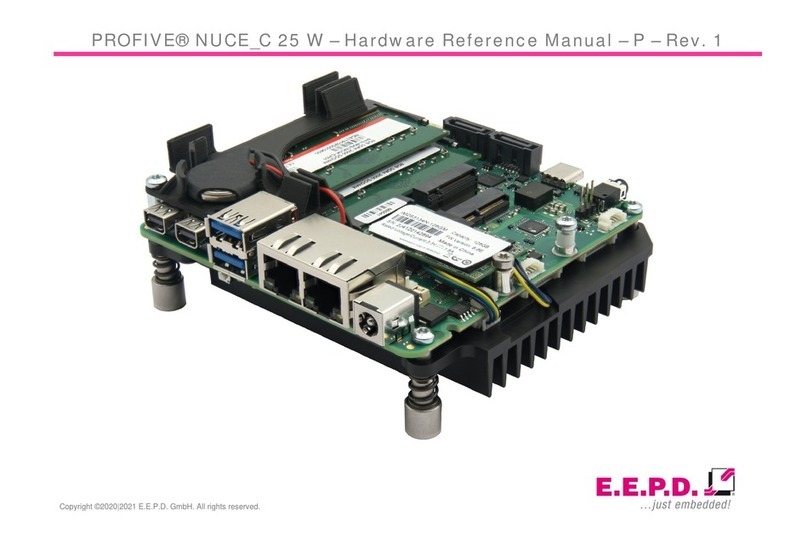
EEPD
EEPD PROFIVE NUCE V2718 Hardware reference manual
Silicon Laboratories
Silicon Laboratories EFR32 Matching Guide
NXP Semiconductors
NXP Semiconductors QN902 Series user manual
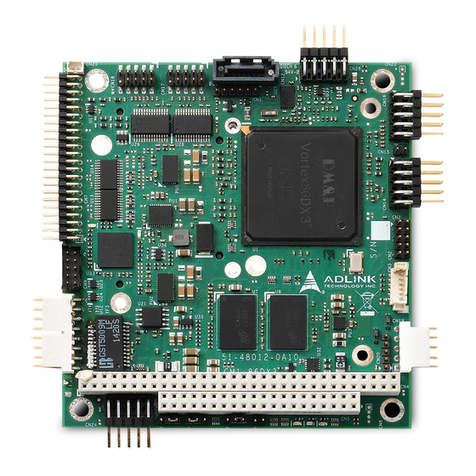
ADLINK Technology
ADLINK Technology CM1-86DX3 Technical reference
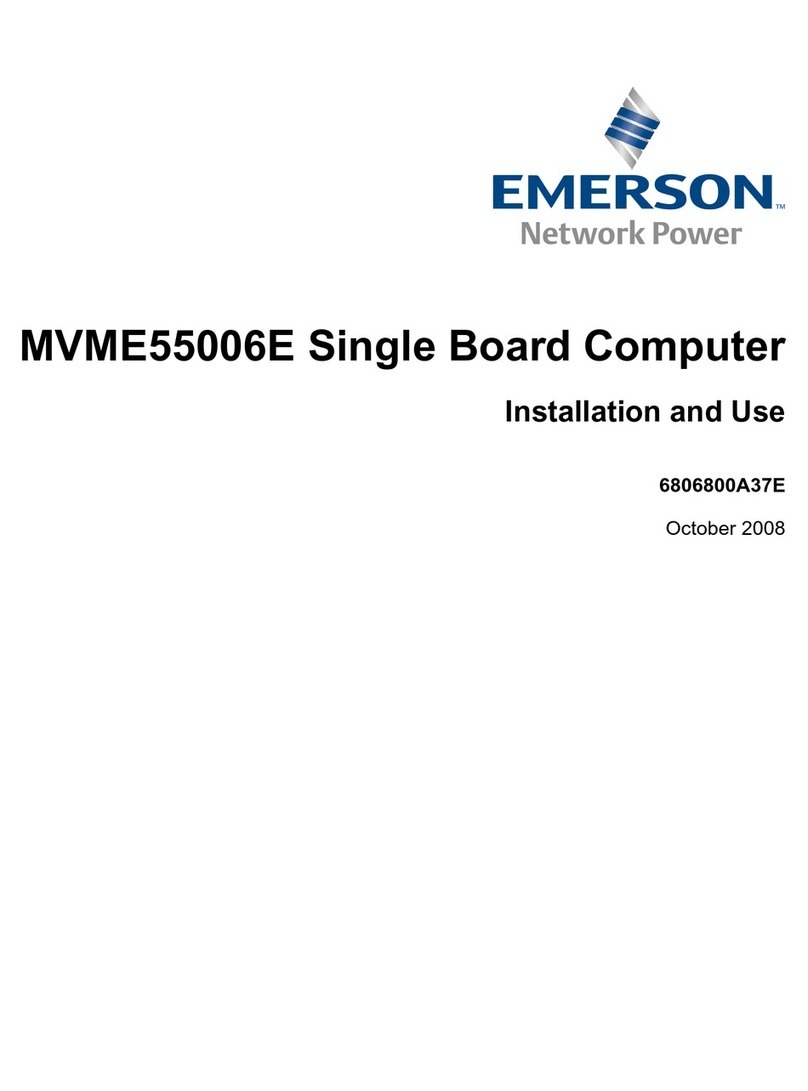
Emerson
Emerson MVME55006E Installation and use
